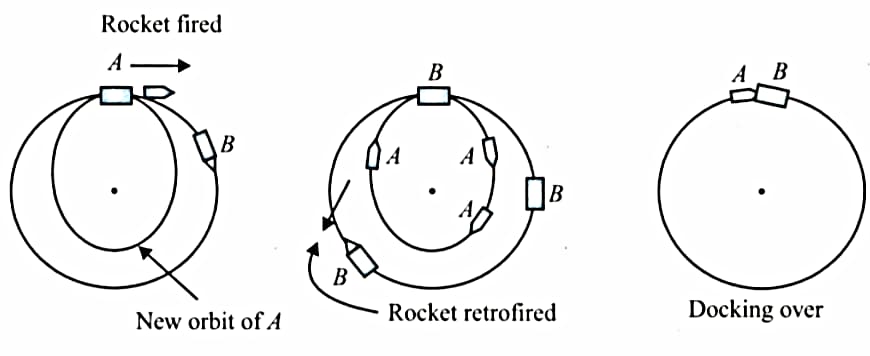Motion of Planets and Satellites
Motion of Planets and Satellites: Overview
This topic covers concepts such as Motion of Satellites, Path of Satellites, Orbital Speed of Satellites, Orbital Time Period of Satellites, Gravitational Potential Energy of Satellites, Kinetic Energy of Satellites, Total Energy of a Satellite, etc.
Important Questions on Motion of Planets and Satellites
Which of the following statement is always true for a binary star system?
Geostationary satellites are widely used for:
The gravitational potential energy of a satellite revolving around the earth in circular orbit is Find the additional energy (in ) that should be given to the satellite so that it escapes from the gravitational field of earth. Assume earth's gravitational force to be the only gravitational force on the satellite and no atmospheric resistance.
Which one is the correct expression for binding energy of a satellite revolving in a circular orbit round the earth.
(Mass earth , mass of satellite, radius of circular orbit )
Three identical bodies of equal mass each are moving along a circle of radius under the action of their mutual gravitational attraction. The speed of each body is
The time period of an earth satellite in circular orbit is independent of
What extra energy should be given to a satellite of mass if it is to be lifted into an orbit of radius and was initially rotating around the earth in circular orbit of radius ?
A satellite of mass which is initially at rest,on earth surface is launched into a circular orbit of double the radius of earth. The radius of earth is . The minimum energy required to do so,is
An unmanned satellite and a spacecraft are orbiting around the earth in the same circular orbit as shown. The spacecraft is ahead of the satellite by some time. Let us consider that some technical problem has arisen in the satellite and the astronaut from has made it correct. For this to be done, docking of two ( and ) is required (in layman terms connecting and ). To achieve this, the rockets of have been fired in forward direction and docking takes place as shown in the figure below:

Take mass of the earth
Radius of the earth
Orbital radius
Mass of satellite
Mass of spacecraft
Assume that initially spacecraft leads satellite by , i.e., arrives at any particular position after of arrival. Based on the above information answer the following question.
To dock and in the above-described situation, one can use the rocket system of either one, i.e., either of or of . To accomplish docking in the minimum possible time, which of the following is the best way?
The satellites when launched from the earth are not given an orbital velocity initially. A multi-stage rocket propeller carries the spacecraft up to its orbit and during each stage rocket has been fired to increase the velocity to acquire the desired velocity for a particular orbit. The last stage of the rocket brings the satellite in circular/elliptical (desired) orbit. Consider a satellite of mass 150 kg in a low circular orbit. In this orbit, we cannot neglect the effect of air drag. This air opposes the motion of satellite and hence the total mechanical energy of earth-satellite system decreases. That means the total energy becomes more negative and hence the orbital radius decreases which causes the increase in kinetic energy. When the satellite comes in the low energy orbit, excessive thermal energy generation due to air friction may cause the satellite to burn up. Based on the above information, answer the following question.
If due to air drag, the orbital radius of the earth decreases from to . Then, the change in is:
The satellites when launched from the earth are not given an orbital velocity initially. A multi-stage rocket propeller carries the spacecraft up to its orbit and during each stage rocket has been fired to increase the velocity to acquire the desired velocity for a particular orbit. The last stage of the rocket brings the satellite in circular/elliptical (desired) orbit. Consider a satellite of mass 150 kg in a low circular orbit. In this orbit, we cannot neglect the effect of air drag. This air opposes the motion of satellite and hence the total mechanical energy of earth-satellite system decreases. That means the total energy becomes more negative and hence the orbital radius decreases which causes the increase in kinetic energy. When the satellite comes in the low energy orbit, excessive thermal energy generation due to air friction may cause the satellite to burn up. Based on the above information, answer the following question.
It has been mentioned in the passage that as decreases, decreases but increases. The increase in is: [ total mechanical energy, orbital radius, kinetic energy]
The period of moon's rotation around the earth is nearly days. If moon's mass were fold its present value, and all other things remain unchanged, the period of moon's rotation would be nearly
Among the solar planetary systems, the planet that is made disqualified recently from the nine major planets is
Speed of a satellite is in its circular orbit. What is the kinetic energy of mass which is ejected from satellite so that it escape from gravitational field of Earth.
A spaceship approaches a planet of mass and radius along a parabolic path which is tangential to its surface. When the spaceship is at the minimum distance from the planet, a brake rocket is fired to convert spaceship into a satellite revolving around the planet in radius . Change in speed of spaceship is,
A period of geostationary satellite is
Which of the following quantities does not depend upon the orbital radius of the satellite?
A ball is dropped from a spacecraft revolving around the earth at a height of , then the ball
Work done by gravitational force on the satellite during half circular rotation around the earth is ( gravitational force between earth and satellite, orbital radius)
